Enhancing the Visibility of SuDS in Strategic Planning Using Preliminary Regional Opportunity Screening
Abstract
:1. Introduction
2. Methods
2.1. Upscaling a Planning Support System to Achieve Regional Screening
2.2. Applying Decision Criteria and Data Types Available at the Outset of Strategic Design
2.3. Devon Case Study
2.4. Open Access Data Sources Used for Analysis
3. Results
4. Discussion
4.1. What Does Our Approach Tell Us about the Potential for SuDS in Devon?
4.2. How Does Our Approach Provide Utility to Decision Support?
4.3. What Are the Limitations of This Approach?
4.4. How Does Our Approach Fit into the Toolkits/Planning Processes Currently in Action/Available?
5. Conclusions
Supplementary Materials
Author Contributions
Funding
Data Availability Statement
Acknowledgments
Conflicts of Interest
References
- Ana, E.V.; Bauwens, W. Modeling the structural deterioration of urban drainage pipes: The state-of-the-art in statistical methods. Urban Water J. 2010, 7, 47–59. [Google Scholar] [CrossRef]
- Djordjević, S.; Butler, D.; Gourbesville, P.; Mark, O.; Pasche, E. New policies to deal with climate change and other drivers impacting on resilience to flooding in urban areas: The CORFU approach. Environ. Sci. Policy 2011, 14, 864–873. [Google Scholar] [CrossRef] [Green Version]
- Westra, S.J.; Fowler, H.J.; Evans, J.P.; Alexander, L.V.; Berg, P.R.; Johnson, F.; Kendon, E.J.; Lenderink, G.; Roberts, N.M. Future changes to the intensity and frequency of short-duration extreme rainfall. Rev. Geophys. 2014, 52, 522–555. [Google Scholar] [CrossRef]
- Guerreiro, S.B.; Dawson, R.J.; Kilsby, C.; Lewis, E.; Ford, A. Future heat-waves, droughts and floods in 571 European cities. Environ. Res. Lett. 2018, 13, 034009. [Google Scholar] [CrossRef]
- Wing, O.E.J.; Bates, P.D.; Smith, A.M.; Sampson, C.C.; Johnson, K.A.; Fargione, J.; Morefield, P. Estimates of present and future flood risk in the conterminous United States. Environ. Res. Lett. 2018, 13, 034023. [Google Scholar] [CrossRef]
- Swain, D.L.; Wing, O.E.J.; Bates, P.D.; Done, J.M.; Johnson, K.A.; Cameron, D.R. Increased Flood Exposure Due to Climate Change and Population Growth in the United States. Earth’s Future 2020, 8, e2020EF001778. [Google Scholar] [CrossRef]
- Fletcher, T.D.; Shuster, W.; Hunt, W.F.; Ashley, R.; Butler, D.; Arthur, S.; Trowsdale, S.; Barraud, S.; Semadeni-Davies, A.; Bertrand-Krajewski, J.-L.; et al. SUDS, LID, BMPs, WSUD and more—The evolution and application of terminology surrounding urban drainage. Urban Water J. 2015, 12, 525–542. [Google Scholar] [CrossRef]
- Schanze, J. Nature-based solutions in flood risk management-Buzzword or innovation? J. Flood Risk Manag. 2017, 10, 281–282. [Google Scholar] [CrossRef]
- Schubert, J.E.; Burns, M.J.; Fletcher, T.D.; Sanders, B.F. A framework for the case-specific assessment of Green Infrastructure in mitigating urban flood hazards. Adv. Water Resour. 2017, 108, 55–68. [Google Scholar] [CrossRef]
- Butler, D.; Digman, C.; Makropoulos, C.; Davies, J. Urban Drainage, 4th ed.; CRC Press: London, UK, 2018. [Google Scholar]
- Thorne, C.; Lawson, E.; Ozawa, C.; Hamlin, S.; Smith, L. Overcoming uncertainty and barriers to adoption of Blue-Green Infrastructure for urban flood risk management. J. Flood Risk Manag. 2018, 11, S960–S972. [Google Scholar] [CrossRef]
- Oral, H.V.; Carvalho, P.; Gajewska, M.; Ursino, N.; Masi, F.; van Hullebusch, E.D.; Kazak, J.; Exposito, A.; Cipolletta, G.; Andersen, T.R.; et al. A review of nature-based solutions for urban water management in European circular cities: A critical assessment based on case studies and literature. Blue-Green Syst. 2020, 2, 112–136. [Google Scholar] [CrossRef] [Green Version]
- Environment Agency. Cost Estimation for SUDS—Summary of Evidence (Report SC080039/R9). 2015. Available online: www.environment-agency.gov.uk (accessed on 30 January 2017).
- Hoang, L.; Fenner, R. System interactions of stormwater management using sustainable urban drainage systems and green infrastructure. Urban Water J. 2015, 13, 739–758. [Google Scholar] [CrossRef] [Green Version]
- Woods Ballard, B.; Wilson, S.; Udale-Clarke, H.; Illman, S.; Scott, T.; Ashley, R.; Kellagher, R. The SuDS Manual (C753); CIRIA: London, UK, 2015. [Google Scholar]
- Ellis, J.B.; Lundy, L. Implementing sustainable drainage systems for urban surface water management within the regulatory framework in England and Wales. J. Environ. Manag. 2016, 183, 630–636. [Google Scholar] [CrossRef] [PubMed]
- Johnson, C.L.; Priest, S.J. Flood Risk Management in England: A Changing Landscape of Risk Responsibility? Int. J. Water Resour. Dev. 2008, 24, 513–525. [Google Scholar] [CrossRef]
- Lamond, J.E.; Rose, C.B.; Booth, C.A. Evidence for improved urban flood resilience by sustainable drainage retrofit. Proc. Inst. Civ. Eng. Urban Des. Plan. 2015, 168, 101–111. [Google Scholar] [CrossRef] [Green Version]
- Wong, T.H.F.; Brown, R.R. The water sensitive city: Principles for practice. Water Sci. Technol. 2009, 60, 673–682. [Google Scholar] [CrossRef] [PubMed] [Green Version]
- Pitt, M. The Pitt Review: Learning Lessons from the 2007 Floods. 2008. Available online: https://webarchive.nationalarchives.gov.uk/ukgwa/20100807034701/http:/archive.cabinetoffice.gov.uk/pittreview/_/media/assets/www.cabinetoffice.gov.uk/flooding_review/pitt_review_full%20pdf.pdf (accessed on 26 October 2021).
- Brown, R.R.; Farrelly, M.A. Delivering sustainable urban water management: A review of the hurdles we face. Water Sci. Technol. 2009, 59, 839–846. [Google Scholar] [CrossRef]
- DCLG. Planning Policy Statement 25: Development and Flood Risk; DCLG: London, UK, 2010. [Google Scholar]
- DEFRA. Surface Water Management Plan Technical Guidance; DEFRA: London, UK, 2010. [Google Scholar]
- HM Government. Flood and Water Management Act 2010. 2010. Available online: http://www.legislation.gov.uk/ukpga/2010/29/pdfs/ukpga_20100029_en.pdf (accessed on 10 May 2017).
- Zhang, K.; Deletic, A.; Dotto, C.B.S.; Allen, R.; Bach, P.M. Modelling a ‘business case’ for blue-green infrastructure: Lessons from the Water Sensitive Cities Toolkit. Blue-Green Syst. 2020, 2, 383–403. [Google Scholar] [CrossRef]
- Commitee on Climate Change. Progress in Preparing for Climate Change. 2015. Available online: www.theccc.org.uk (accessed on 10 May 2017).
- Kabisch, N.; Frantzeskaki, N.; Pauleit, S.; Naumann, S.; Davis, M.; Artmann, M.; Haase, D.; Knapp, S.; Korn, H.; Stadler, J.; et al. Nature-based solutions to climate change mitigation and adapta-tion in urban areas: Perspectives on indicators, knowledge gaps, barriers, and opportunities for action. Ecol. Soc. 2016, 21. Available online: https://www.jstor.org/stable/26270403 (accessed on 16 June 2021). [CrossRef] [Green Version]
- Kuller, M.; Farrelly, M.; Deletic, A.; Bach, P.M. Building effective Planning Support Systems for green urban water infrastructure—Practitioners’ perceptions. Environ. Sci. Policy 2018, 89, 153–162. [Google Scholar] [CrossRef]
- Giese, E.; Rockler, A.; Shirmohammadi, A.; Pavao-Zuckerman, M.A. Assessing Watershed-Scale Stormwater Green Infrastructure Response to Climate Change in Clarksburg, Maryland. J. Water Resour. Plan. Manag. 2019, 145, 05019015. [Google Scholar] [CrossRef]
- Webber, J.L.; Fletcher, T.D.; Cunningham, L.; Fu, G.; Butler, D.; Burns, M.J. Is green infrastructure a viable strategy for managing urban surface water flooding? Urban Water J. 2020, 17, 598–608. [Google Scholar] [CrossRef] [Green Version]
- O’Donnell, E.C.; Lamond, J.E.; Thorne, C.R. Recognising barriers to implementation of Blue-Green Infrastructure: A Newcastle case study. Urban Water J. 2017, 14, 964–971. [Google Scholar] [CrossRef] [Green Version]
- O’Donnell, E.; Thorne, C.; Ahilan, S.; Arthur, S.; Birkinshaw, S.; Butler, D.; Dawson, D.; Everett, G.; Fenner, R.; Glenis, V.; et al. The blue-green path to urban flood resilience. Blue-Green Syst. 2020, 2, 28–45. [Google Scholar] [CrossRef] [Green Version]
- Cettner, A. Overcoming Inertia to Sustainable Stormwater Management Practice; Luleå University of Technology: Luleå, Switzerland, 2012. [Google Scholar]
- Gersonius, B.; Nasruddin, F.; Ashley, R.; Jeuken, A.; Pathirana, A.; Zevenbergen, C. Developing the evidence base for mainstreaming adaptation of stormwater systems to climate change. Water Res. 2012, 46, 6824–6835. [Google Scholar] [CrossRef]
- Ellis, J. Sustainable surface water management and green infrastructure in UK urban catchment planning. J. Environ. Plan. Manag. 2013, 56, 24–41. [Google Scholar] [CrossRef]
- Fenner, R. Spatial Evaluation of Multiple Benefits to Encourage Multi-Functional Design of Sustainable Drainage in Blue-Green Cities. Water 2017, 9, 953. [Google Scholar] [CrossRef] [Green Version]
- Ossa-Moreno, J.; Smith, K.M.; Mijic, A. Economic analysis of wider benefits to facilitate SuDS uptake in London, UK. Sustain. Cities Soc. 2017, 28, 411–419. [Google Scholar] [CrossRef] [Green Version]
- DEFRA. Surface Water Management An Action Plan. 2018. Available online: www.nationalarchives.gov.uk/doc/open-government-licence/version/3/oremailPSI@nationalarchives.gsi.gov.ukwww.gov.uk/defra (accessed on 20 April 2020).
- Webber, J.L.; Fu, G.; Butler, D. Comparing cost-effectiveness of surface water flood management interventions in a UK catchment. J. Flood Risk Manag. 2019, 12, e12523. [Google Scholar] [CrossRef] [Green Version]
- Mijic, A.; Ossa-Moreno, J.; Smith, K.M. Multifunctional benefits of SuDS: Techno-economic evaluation of decentralised solutions for urban water management. Geophys. Res. Abstr. EGU Gen. Assem. 2016, 18, 2016–9994. Available online: http://meetingorganizer.copernicus.org/EGU2016/EGU2016-9994.pdf (accessed on 24 August 2017).
- Lechner, A.M.; Gomes, R.L.; Rodrigues, L.; Ashfold, M.J.; Selvam, S.B.; Wong, E.P.; Raymond, C.M.; Zieritz, A.; Sing, K.W.; Moug, P.; et al. Challenges and considerations of applying nature-based solutions in low- and middle-income countries in Southeast and East Asia. Blue-Green Syst. 2020, 2, 331–351. [Google Scholar] [CrossRef]
- Tozer, L.; Hörschelmann, K.; Anguelovski, I.; Bulkeley, H.; Lazova, Y. Whose city? Whose nature? Towards inclusive nature-based solution governance. Cities 2020, 107, 102892. [Google Scholar] [CrossRef]
- Frantzeskaki, N. Seven lessons for planning nature-based solutions in cities. Environ. Sci. Policy 2019, 93, 101–111. [Google Scholar] [CrossRef]
- Kuller, M.; Bach, P.M.; Roberts, S.; Browne, D.; Deletic, A. A planning-support tool for spatial suitability assessment of green urban stormwater infrastructure. Sci. Total Environ. 2019, 686, 856–868. [Google Scholar] [CrossRef] [PubMed]
- Kuller, M.; Bach, P.M.; Ramirez-Lovering, D.; Deletic, A. Framing water sensitive urban design as part of the urban form: A critical review of tools for best planning practice. Environ. Model. Softw. 2017, 96, 265–282. [Google Scholar] [CrossRef]
- The Rivers Trust. Is My River Fit to Play in? 2021. Available online: https://www.arcgis.com/apps/webappviewer/index.html?id=a6dd42e3bc264fc28134c64c00db4a5b&extent=-401307.0872%2C6628364.5565%2C-130261.3849%2C6788576.5678%2C102100 (accessed on 5 May 2021).
- BBC News. Flash Floods Hit Devon Village of Clovelly. 2012. Available online: https://www.bbc.co.uk/news/av/uk-19918705 (accessed on 2 July 2021).
- Lynton & Lynmouth. The 1952 Lynmouth Flood Disaster. 2020. Available online: https://visitlyntonandlynmouth.com/history-heritage/the-1952-lynmouth-flood-disaster/ (accessed on 2 July 2021).
- South West Partnership for Environmental and Economic Prosperity. The South West Partnership for Environmental and Economic Prosperity. 2020. Available online: https://sweep.ac.uk/ (accessed on 23 April 2020).
- Centre for Ecology and Hydrology. Land Cover Map 2019; Centre for Ecology and Hydrology: Wallingford, UK, 2020. [Google Scholar]
- Ordnance Survey. Terrain 50 Elevation Model. 2020. Available online: https://www.ordnancesurvey.co.uk/business-government/products/terrain-50 (accessed on 23 April 2020).
- Ordnance Survey. OS Open Zoomstack. 2020. Available online: https://www.ordnancesurvey.co.uk/business-government/products/open-zoomstack (accessed on 14 May 2021).
- Ordnance Survey. OS Open Roads. 2020. Available online: https://www.ordnancesurvey.co.uk/business-government/products/open-map-roads (accessed on 14 May 2021).
- UK Government. Land Value Estimates for Policy Appraisal 2019. 2020. Available online: https://www.gov.uk/government/publications/land-value-estimates-for-policy-appraisal-2019 (accessed on 14 May 2021).
- Environment Agency. Flood Map for Planning Risk. 2013. Available online: http://apps.environment-agency.gov.uk/wiyby/cy/151263.aspx (accessed on 23 July 2021).
- South West Water. Upstream Thinking 2015–2020: An Overview of Progress Contributing to 10 Years of Upstream Thinking in the South West UK. 2020. Available online: www.southwestwater.co.uk/siteassets/document-repository/environment/j121-sww-ust-v7-290920.pdf (accessed on 5 May 2021).
- Balmforth, D.; Digman, C.; Kellagher, R.; David, B. Desiging for Exceedance in Urban Drainage-Good Practice; CIRIA: London, UK, 2006; pp. 174–180. [Google Scholar]
- Committee on Climate Change. UK Climate Change Risk Assessment 2017 Synthesis Report. 2017. Available online: https://www.theccc.org.uk/wp-content/uploads/2016/07/UK-CCRA-2017-Synthesis-Report-Committee-on-Climate-Change.pdf (accessed on 4 July 2017).
- CIRIA. BeST (Benefits of SuDS Tool) W045d BeST—User Manual Release Version 1; CIRIA: London, UK, 2015; pp. 1–22. [Google Scholar]
- White, I.; Connelly, A.; Garvin, S.; Lawson, N.; O’Hare, P. Flood resilience technology in Europe: Identifying barriers and co-producing best practice. J. Flood Risk Manag. 2018, 11, S468–S478. [Google Scholar] [CrossRef]
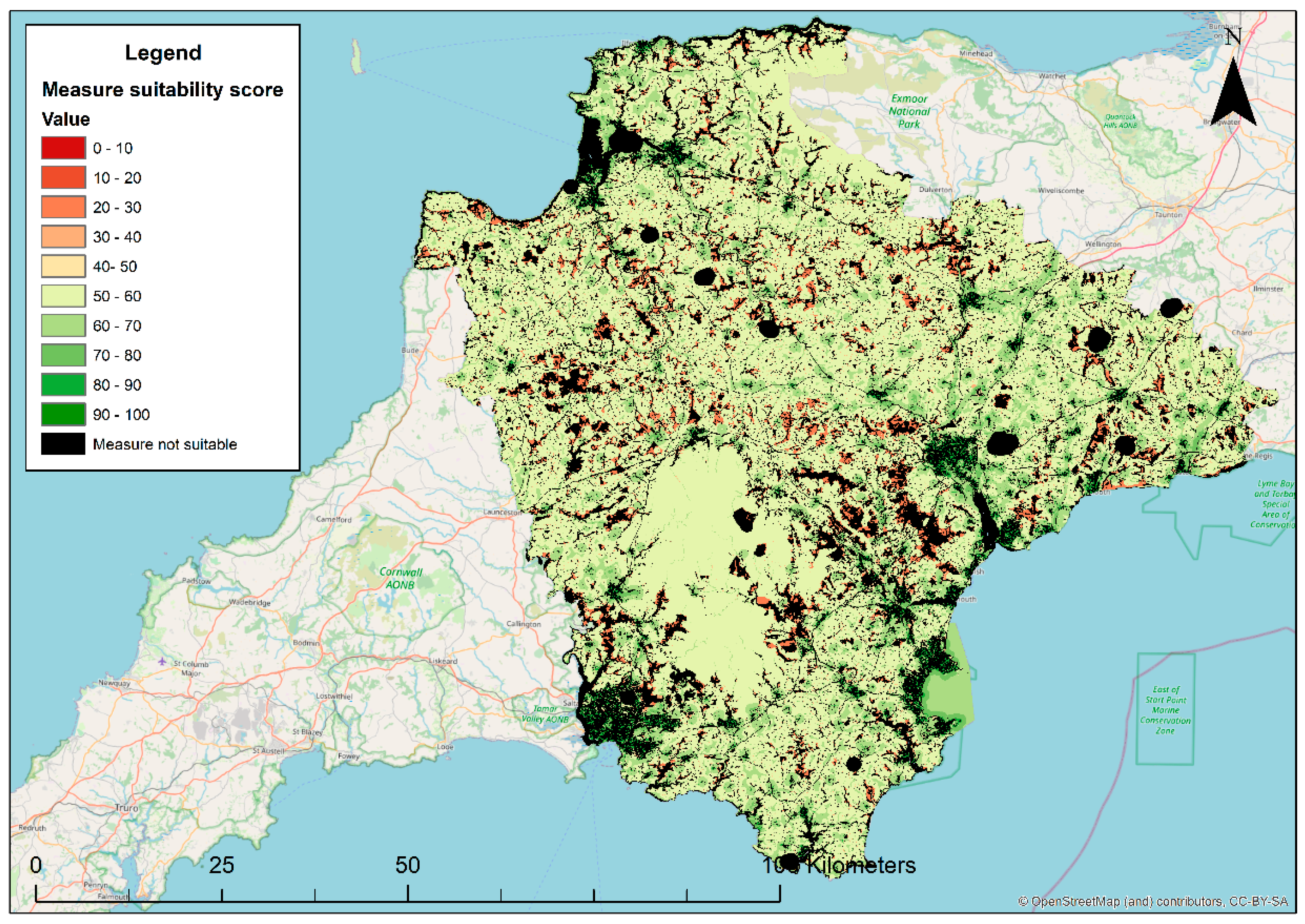
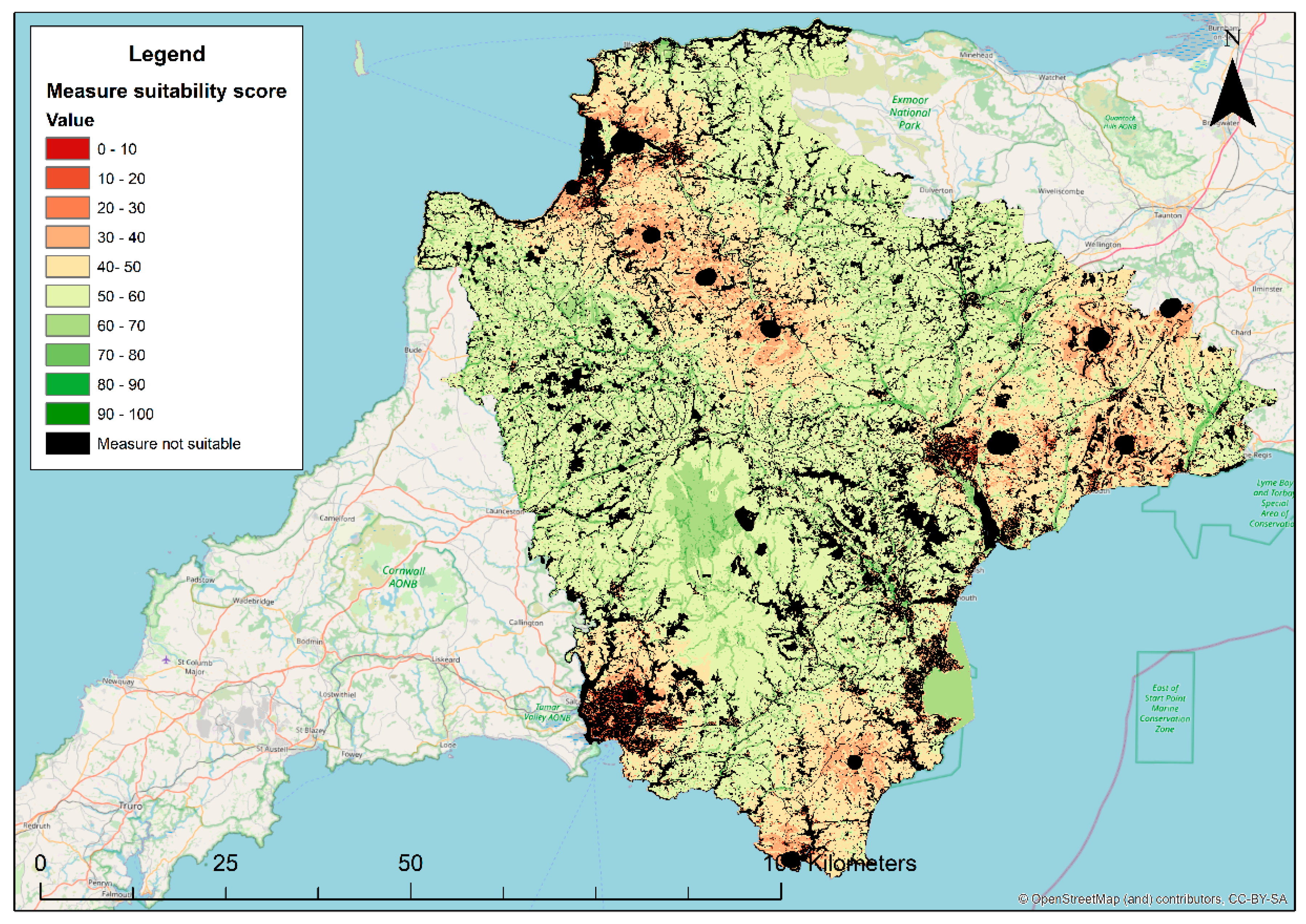
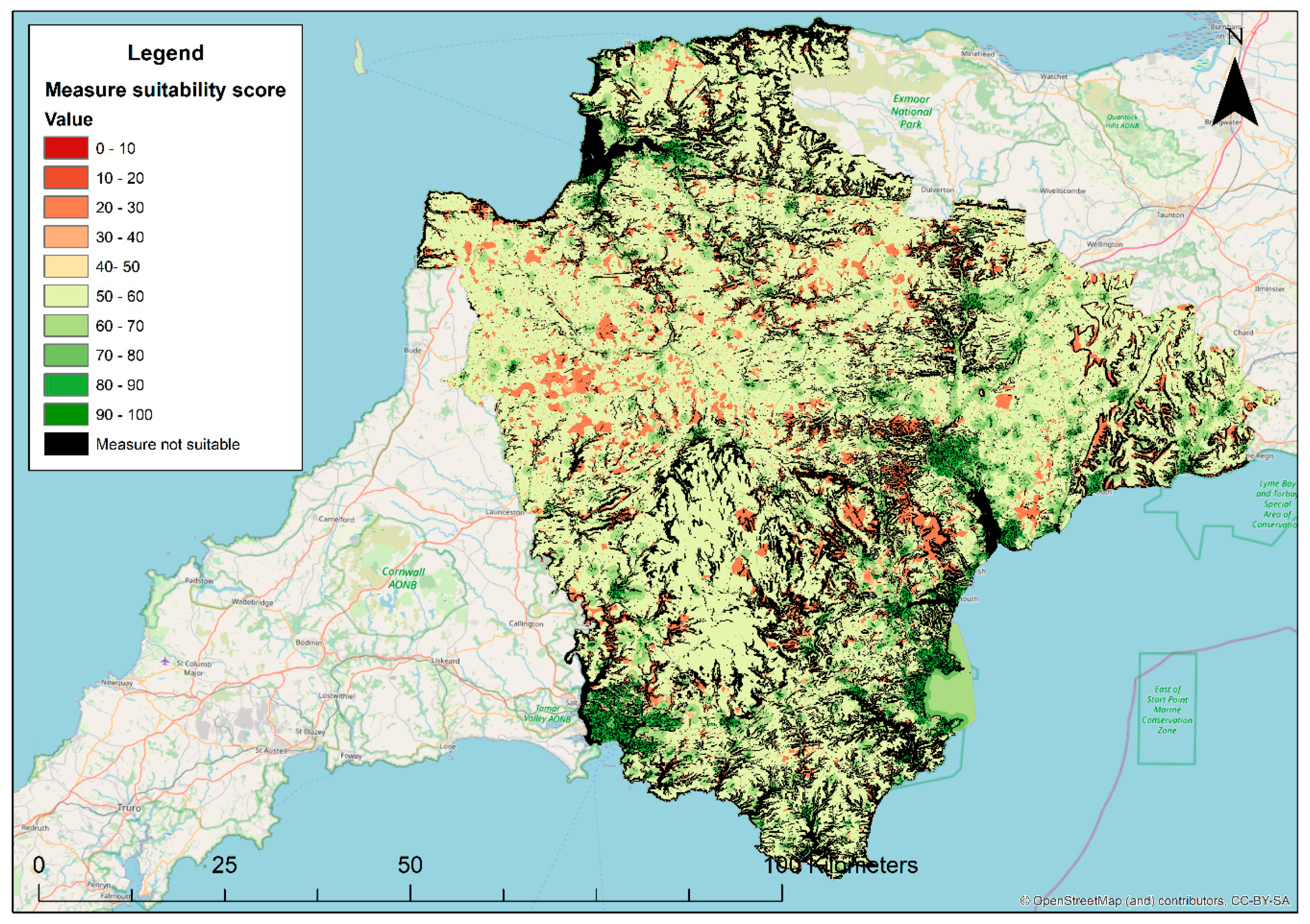
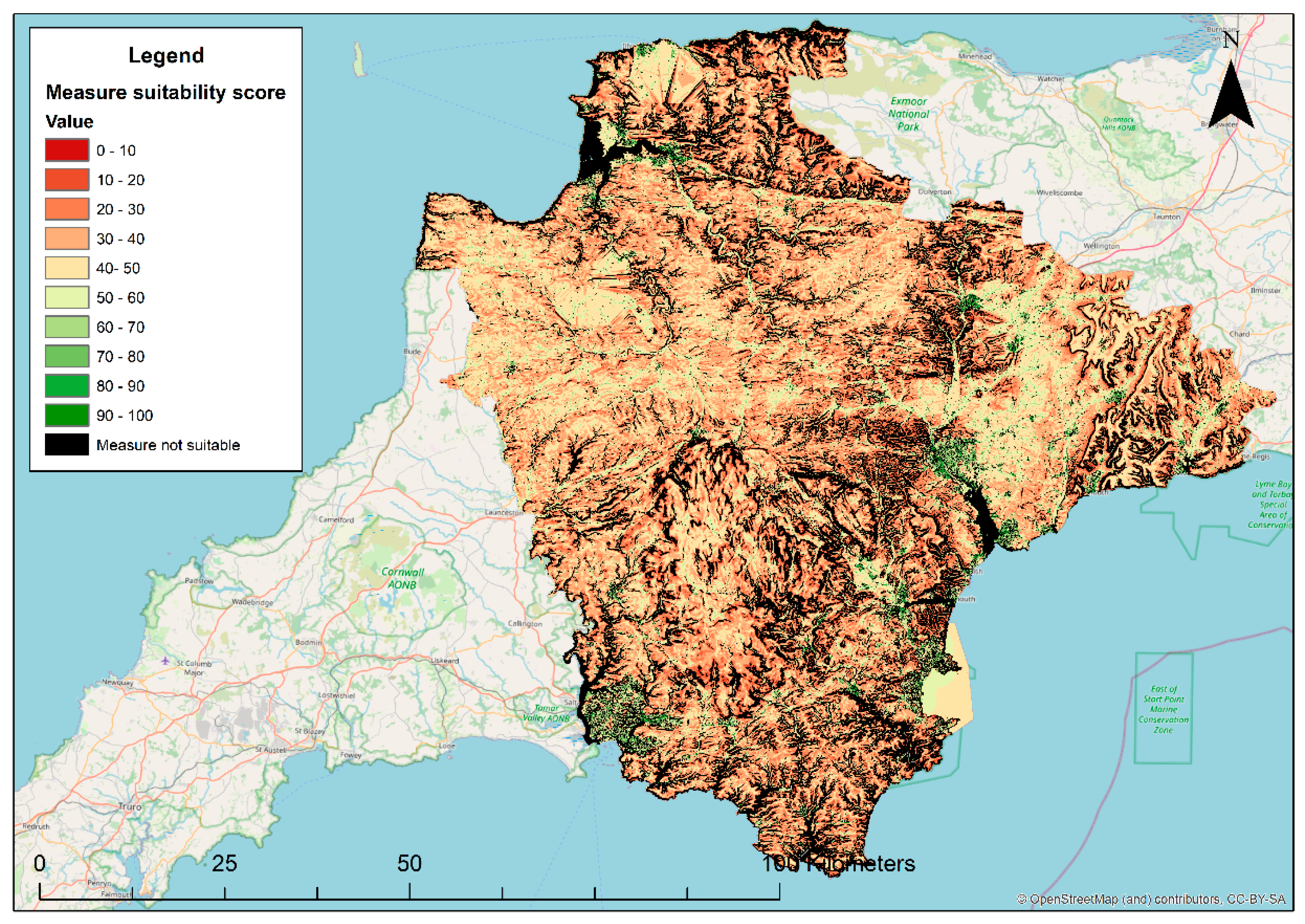
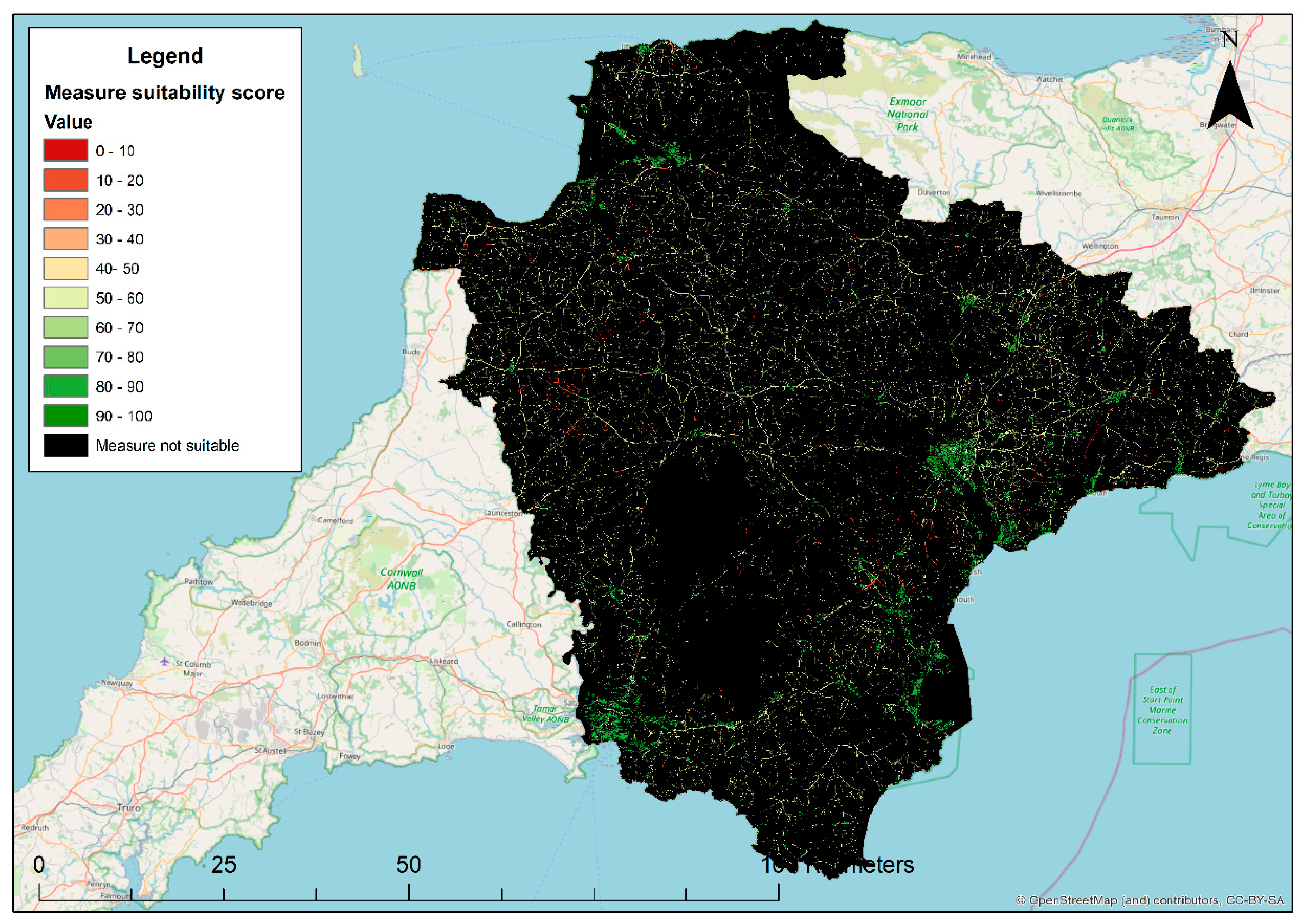
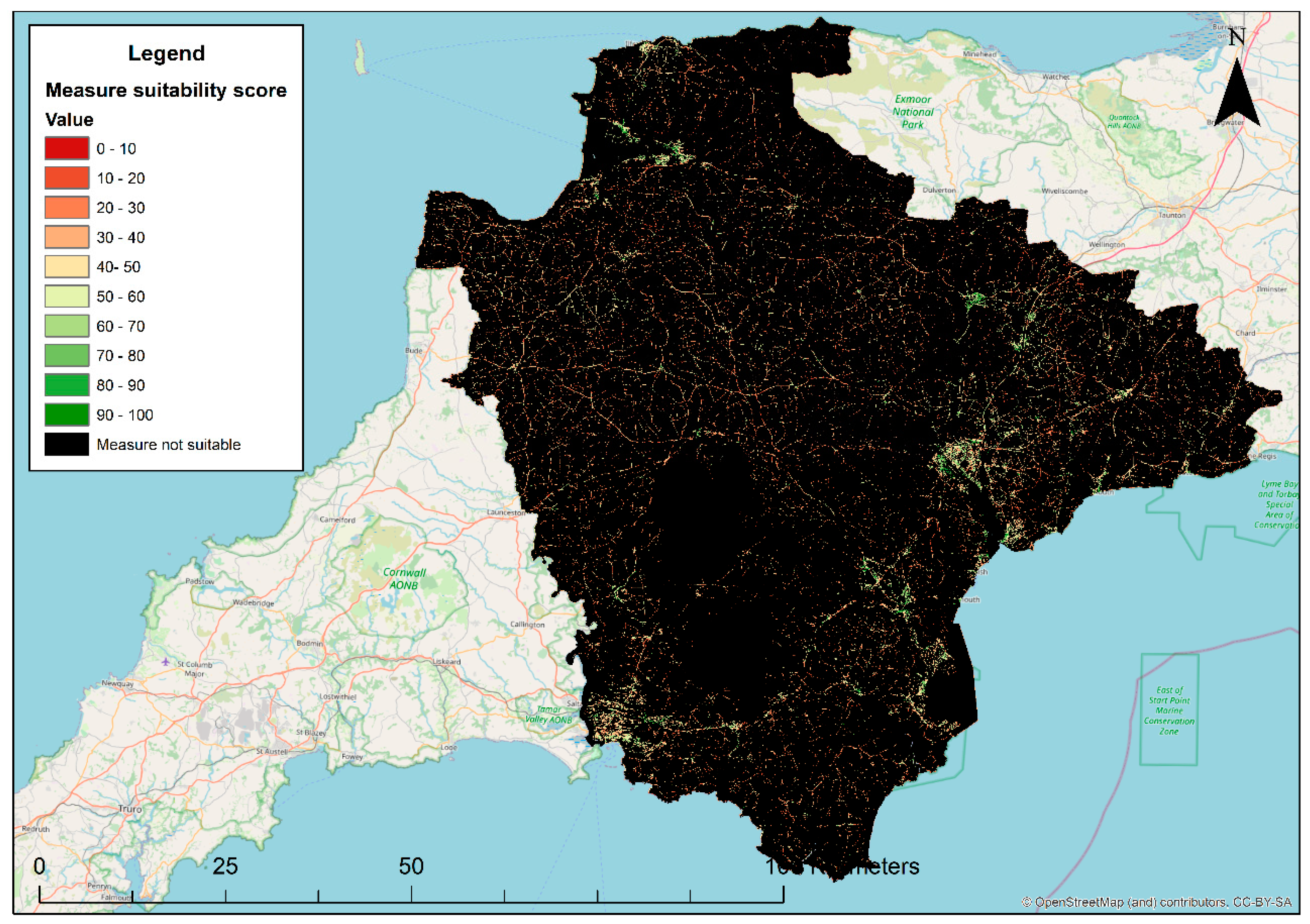
| Criterion | SuDS | Source |
|---|---|---|
| Opportunities | ||
| Land cover | RG, IS, GR, PL, SW, CW | Devon land cover mapping gathered from Centre for Ecology and Hydrology 2019 land cover mapping. |
| Slope | RG, IS, SW, CW | Ordnance Survey 50 m resolution elevation model. |
| Building footprints | RG, IS, GR, PL, SW, RT, CW | Aggregated building footprint shapefile from OS Zoomstack product. |
| Surface water | RT | Features extracted from OS Zoomstack product. |
| Distance to waterways | RG, PL, SW, CW | Features extracted from OS Zoomstack product. |
| Distance to airports | PL, CW | Features extracted from OS Zoomstack product. |
| Street and street width/type | RG, PL, SW, CW | OS Open Roads product. |
| Land value | RG, GR, PL, SW, CW | Centre for Ecology and Hydrology 2019 land cover mapping. |
| Needs | ||
| Distance to irrigation demand | RG, PL, RT, CW | Features extracted from OS Zoomstack product. |
| Total imperviousness | RG, IS, GR, PL, SW, RT, CW | Centre for Ecology and Hydrology 2019 land cover mapping. |
| Floods | RG, IS, GR, PL, SW, RT, CW | Environment Agency Flood Zone 2. |
| Green cover | RG, IS, GR, SW, CW | Features extracted from OS Zoomstack product. |
| Recreation | PL, CW | Features extracted from OS Zoomstack product. |
Publisher’s Note: MDPI stays neutral with regard to jurisdictional claims in published maps and institutional affiliations. |
© 2021 by the authors. Licensee MDPI, Basel, Switzerland. This article is an open access article distributed under the terms and conditions of the Creative Commons Attribution (CC BY) license (https://creativecommons.org/licenses/by/4.0/).
Share and Cite
Webber, J.L.; Kuller, M. Enhancing the Visibility of SuDS in Strategic Planning Using Preliminary Regional Opportunity Screening. ISPRS Int. J. Geo-Inf. 2021, 10, 726. https://doi.org/10.3390/ijgi10110726
Webber JL, Kuller M. Enhancing the Visibility of SuDS in Strategic Planning Using Preliminary Regional Opportunity Screening. ISPRS International Journal of Geo-Information. 2021; 10(11):726. https://doi.org/10.3390/ijgi10110726
Chicago/Turabian StyleWebber, James L., and Martijn Kuller. 2021. "Enhancing the Visibility of SuDS in Strategic Planning Using Preliminary Regional Opportunity Screening" ISPRS International Journal of Geo-Information 10, no. 11: 726. https://doi.org/10.3390/ijgi10110726
APA StyleWebber, J. L., & Kuller, M. (2021). Enhancing the Visibility of SuDS in Strategic Planning Using Preliminary Regional Opportunity Screening. ISPRS International Journal of Geo-Information, 10(11), 726. https://doi.org/10.3390/ijgi10110726







